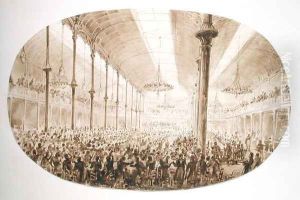Hector Horeau Paintings
Hector Horeau was a visionary French architect, watercolorist, and theorist who was born on September 22, 1801, in Versailles, France. He is known for his innovative ideas and designs, many of which were ahead of their time and not realized during his life. Horeau was educated at the École des Beaux-Arts in Paris and was a contemporary of other notable architects like Eugène Viollet-le-Duc and Henri Labrouste.
Horeau's work was characterized by his use of panoramic perspectives, a technique he used to create immersive architectural drawings that conveyed the experience of the viewer within the space. His designs often featured organic forms, extensive use of glass, and prefabricated elements, anticipating some of the developments of modern architecture.
One of his most famous projects was his 1841 competition entry for the design of the new Palace of Westminster in London, which had been destroyed by fire in 1834. His submission was innovative, featuring a series of circular and hexagonal halls topped by a massive dome; however, it was not accepted. His other notable works include a plan for a utopian city called 'Cité des Fleurs,' which incorporated social ideas and urban planning concepts that would only come to prominence much later.
Despite his forward-thinking ideas, Horeau struggled to gain commissions, and many of his projects remained on paper. He published several books where he expressed his theoretical views on architecture, including 'Architecture Polychrome chez les Grecs' (1844) and 'Panorama d'Égypte et de Nubie' (1841). In these works, he asserted the importance of color in Greek architecture and documented his travels in Egypt, respectively.
Horeau's lack of built work meant that he was largely forgotten after his death on July 9, 1872. However, in the 20th century, his drawings and theoretical writings were rediscovered, leading to a renewed interest in his contributions to architectural thought. Today, he is recognized for his role in the development of architectural visualization and as a pioneer of ideas that would later be embraced by modernism.
